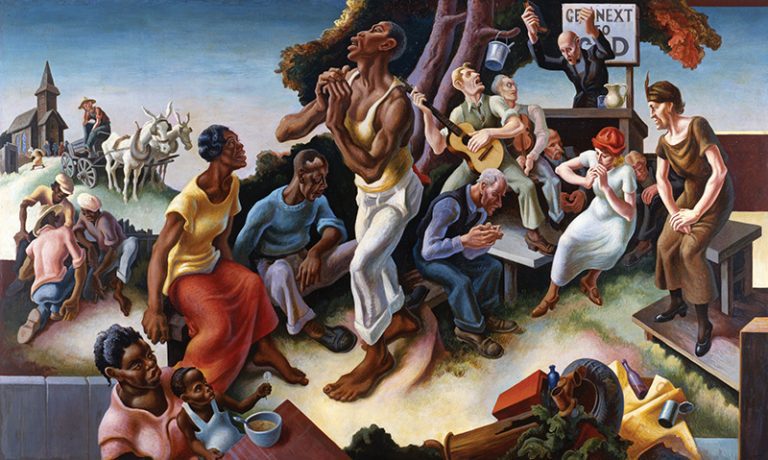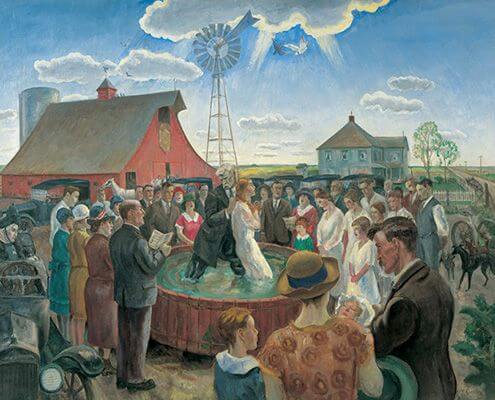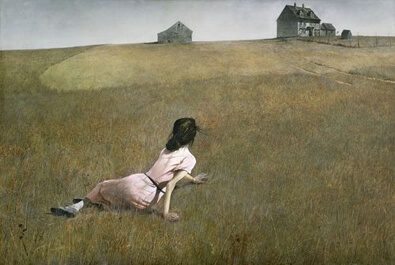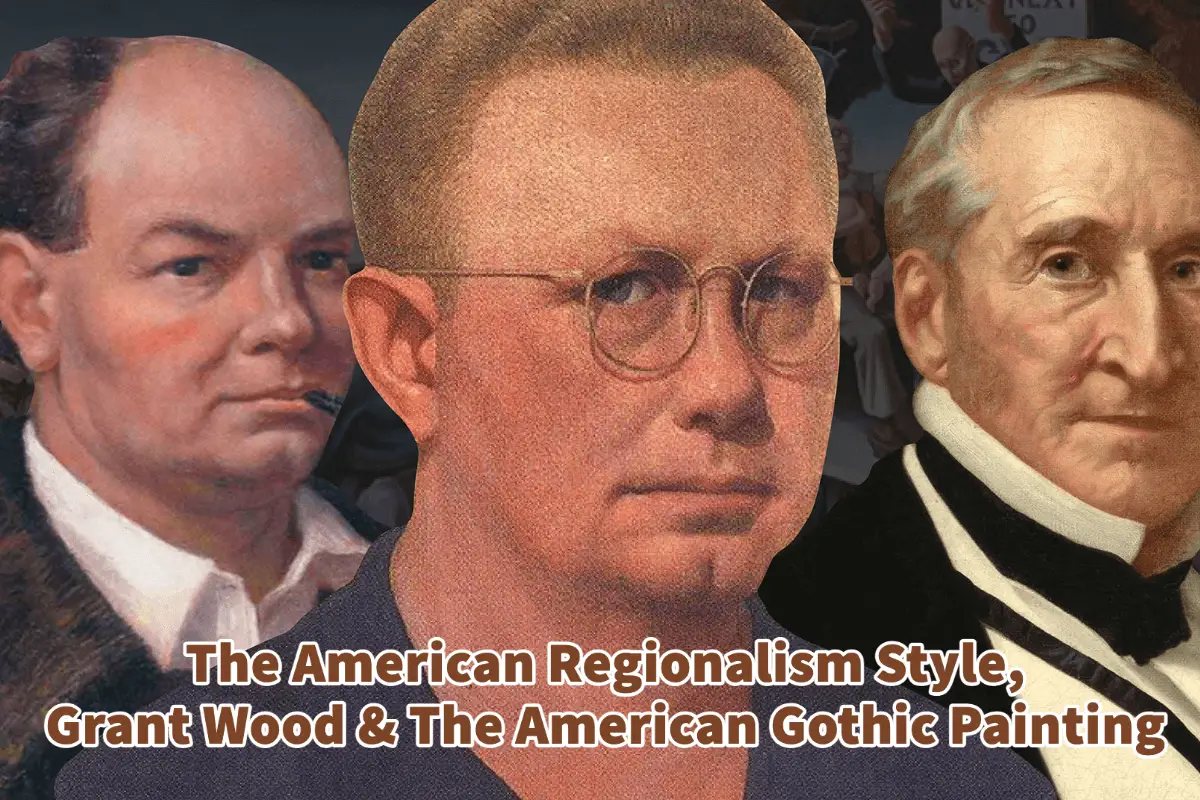One of the most iconic American paintings is the art by Grant Wood, known as American Gothic. This painting is perhaps one of the best well-known American Regionalism paintings.
The American Regionalism art style was a movement that was popular during the American Great Depression. The movement was about painting a realistic picture of America’s rural countryside, most notable in the midwestern United States. One of the most iconic paintings for that style was Grant Wood’s American Gothic painting.
Table of Contents
- American Regionalism Art Defined
- The American Regionalist Triumvirate
- Importance Of American Regionalism Art Movement
- Grant Wood, American Regionalism Movement, And The American Gothic
- Frequently Asked Questions
- Related Questions
American Regionalism Art Defined
American Regionalism is an American realistic art movement that included many paintings, murals, lithographs, and illustrations. American regionalism depicted realistic scenes of rural and small-town America, primarily in the mid-western part of the United States.
American Regionalism reached popularity from the 1930s to 1935; during the Great Depression, it showed reassuring images of the American heartland. Even though many of the paintings and artists have many stylistic differences, regionalism art was considered a relatively conservative and traditionalist style that appealed to American sensibilities.
Before World War II, there was a struggle to define the context of American art and how the art fits into the global world. Many American artists rejected the modern trends coming from European influences, especially from the school of Paris.
By rejecting these European abstract styles, the American artist chose instead to adopt an academic realism that depicted American urban and rule scenes. In other words, the main focus of this art movement was to produce some realistic urban and rural scenes from mainly the heartland of America or the American Midwest.
American Regionalism movement became one of the dominant movements in America in the 1930s. The other movement was social realism. During this time in American history, America was still a predominately agricultural nation. Only a tiny part of the population lived in industrial cities such as New York or Chicago, with most American populations living out on farms.
The American Regionalism movement appealed to many rule Americans who lived and worked out in farming communities.
The American Regionalist Triumvirate

In the American Regionalism movement, there’s also what is known as the Regionalist Triumvirate, which consisted of three highly respected American realism artists. The three artists in the American Regionalist Triumvirate included Grant Wood, Thomas Hart Benton, and John Stewart Curry.

All three of these artists studied in Paris, but they devoted their lives to creating a truly American art form. They were highly respected American artists during the Great Depression era.
What joined them all together was that they believed that the solution to urban problems in American life and the Great Depression was for the United States to return to its rural agricultural roots. Because of this, they painted a lot of the rural agrarian paintings of the American Midwest.
Importance Of American Regionalism Art Movement
The most important thing that American Regionalism art did was limit the spread of abstract art from Europe to dominate the American art scene; this allowed American art to gain confidence and not rely solely upon European styles. In other words, American Regionalism helped American art to get its jumpstart in the art world.

Listen To Our Podcast About How American Regionalism Changed American Art below or by clicking here.
Ther American Regionalism art was the art movement that helped bridge the gap and make way for the American Abstract Expressionism art movement started by Benton’s pupil Jackson Pollock. Benton helped to influence Jackson Pollock and his art.
When World War II ended, this ushered in a new era and change for the world. That change also brought the decline of the American Regionalism Art Movement. But not without influencing some other predominate American artists like Norman Rockwell and Andrew Wyeth.

Andrew Wyeth, in 1948, painted the iconic American painting known as Christina’s World. This painting is considered one of the most important paintings of the middle 20th Century. And like the American Gothic painting has been seen in many parts of American popular culture.
Grant Wood, American Regionalism Movement, And The American Gothic

Perhaps one of the single most important paintings in the American Regionalism art movement is Grant Woods Painting, American Gothic. Grant was from Anamosa, Iowa, so he understood the American Midwest agricultural lifestyle.
He also famously wrote a pamphlet about American Regionalism entitled Revolt Against the City, published in Iowa City in 1935. In this pamphlet, he had said that American artists were no longer looking to the Parisian culture for the subject matter but instead, are looking to America.
He asserted that American artists could better interpret the industry and psychology of their hometown than those artists who were from Europe or other places. He also wrote that he believed the city’s life was gone and hoped America would continue to be an agricultural base nation.
Grant Woods’ painting of American Gothic is an excellent example of American Regionalism. When most people think about American Regionalism, they think of Grant Wood’s iconic painting known as American Gothic. This painting speaks to them about rural life in America or how life once was for most Americans.
Anita Louise Art is dedicated to art education, great artists, and inspiring others to find and create their art. We love art that uplifts and inspires. #ArtToMakeYouSmile! #ArtToMakeYouHappy!
If you are interested to see any of my art, you can find out more by clicking here. If you are interested in what inspires me and my paintings, you can discover more by clicking here.
We have a free newsletter and would love you to be part of our community; you can subscribe to the newsletter by clicking here. If you have any questions, I would be happy to talk to you any time. You can reach me, Anita, by clicking here.
Subscribe to our Anita Louise Art YouTube Channel filled with great videos and information by clicking here.
Frequently Asked Questions
What is American Regionalism?
American Regionalism was an art movement popular during the Great Depression, focused on depicting the rural American countryside, particularly in the Midwest.
When did the American Regionalism movement emerge?
The American Regionalism movement emerged in the 1930s, during the Great Depression.
Who was the artist behind the iconic American Regionalism painting “American Gothic”?
The artist behind the iconic “American Gothic” painting was Grant Wood.
What is the significance of Grant Wood’s “American Gothic” painting?
“American Gothic” is one of the most well-known and iconic paintings of the American Regionalism movement, symbolizing the values and spirit of rural America.
What is the subject matter of American Regionalism paintings?
American Regionalism paintings often depicted scenes from rural life, including landscapes, farms, small towns, and ordinary people engaged in everyday activities.
What were the main characteristics of American Regionalism art?
The main characteristics of American Regionalism art include a realistic and detailed style, emphasis on rural life, use of local subjects, and a sense of national pride.
How did the Great Depression influence the American Regionalism movement?
The Great Depression had a significant impact on the American Regionalism movement, as artists sought to capture the struggles and realities of rural communities during that time.
Who were some other notable artists associated with American Regionalism?
Besides Grant Wood, other notable artists associated with American Regionalism include Thomas Hart Benton, John Steuart Curry, and Grant Wood’s sister, Nan Wood Graham.
Did “American Gothic” receive immediate acclaim?
Yes, “American Gothic” gained immediate acclaim and won a bronze medal at the Art Institute of Chicago’s annual exhibition in 1930. It quickly became an iconic representation of American art and culture.
How did the public and art critics initially react to the painting?
Initial reactions were mixed. While some praised the painting for its skillful execution and representation of American life, others criticized it for its perceived mockery of rural people. Over time, however, the painting gained widespread acceptance and is now considered a masterpiece.
What impact did the American Regionalism movement have on the art world?
The American Regionalism movement brought attention to the importance of depicting regional cultures and landscapes in art. It provided a counterpoint to abstract and avant-garde styles prevalent at the time, emphasizing a return to traditional, representational art.
How has “American Gothic” influenced contemporary art and popular culture?
“American Gothic” has had a lasting impact, inspiring numerous parodies, references, and adaptations in contemporary art, advertising, and popular culture. Its imagery is often used to comment on American values, identity, and societal changes.
Related Questions
How Was Leonardo da Vinci Able To Master So Many Different Professions?
Leonardo da Vinci is a man known to have had many different titles and professions during his lifetime. He was able to master this profession because he was a genius. But more than just being a genius, Leonardo is also self-educating and never stops learning. He had an insatiable amount of curiosity about all kinds of subjects.
By clicking here, you can learn more by reading How Was Leonardo da Vinci Able To Master So Many Different Professions?.
Was Leonardo da Vinci A Philosopher?
Leonardo da Vinci was a philosopher; being a philosopher means that you want to seek wisdom. Leonardo was one person who wanted to seek wisdom or enlightenment in his life. Leonardo was an active observer and learner of the human body, human behavior, and nature.
By clicking here, you can learn more by reading Was Leonardo da Vinci A Philosopher?.

